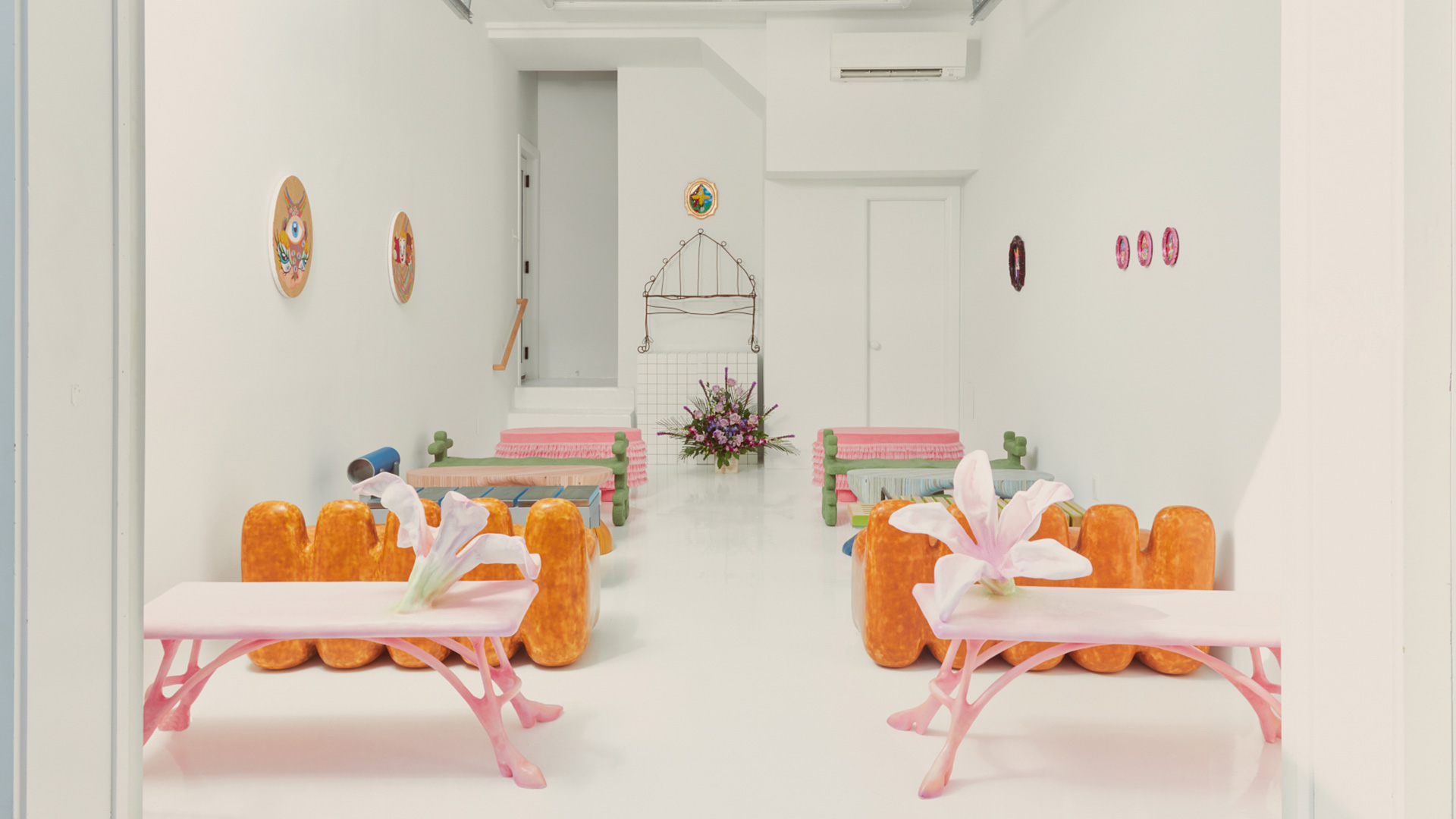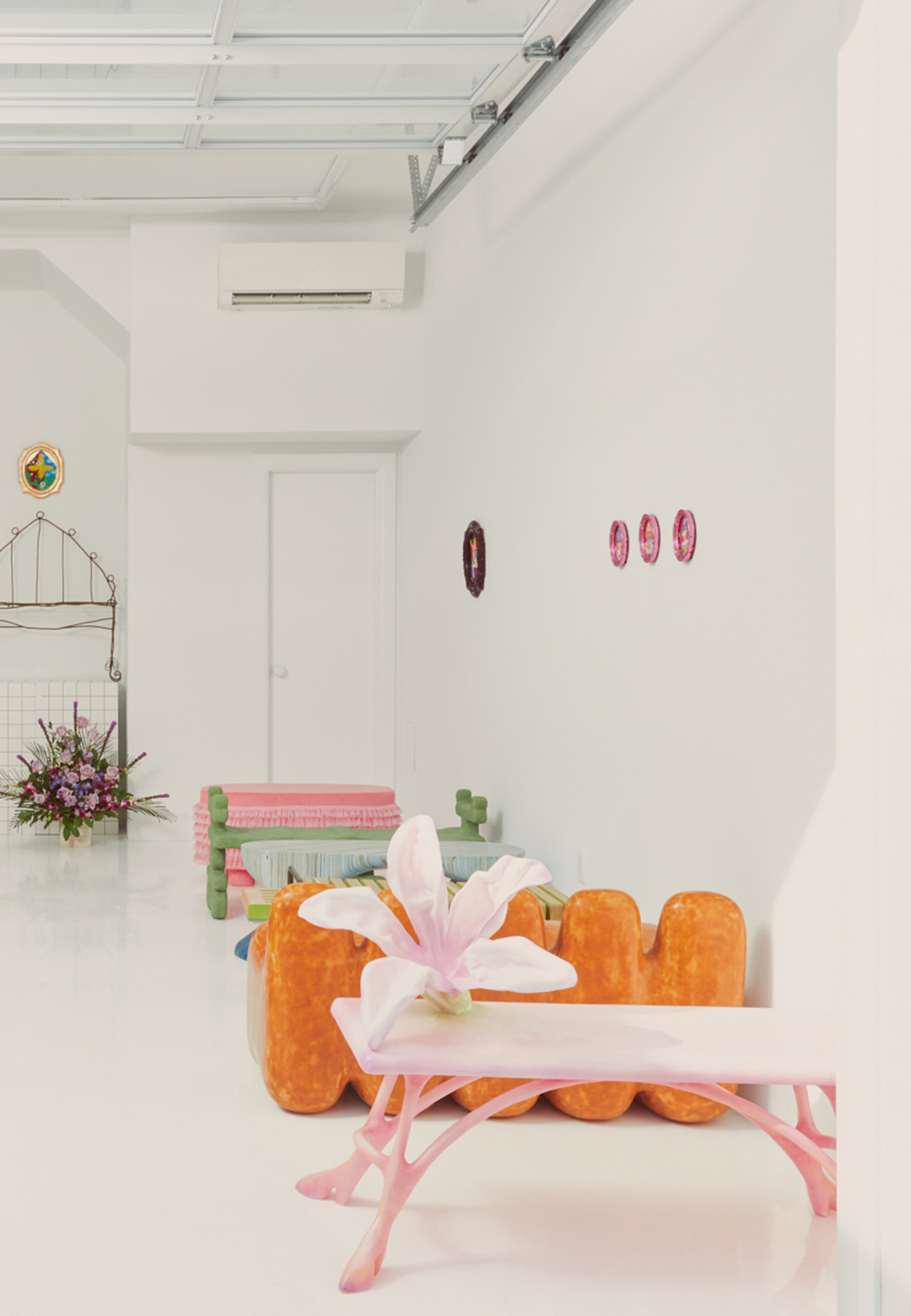Friends Artspace, an art and design gallery within a modestly structured gable roof building in Arlington, Virginia, bears resemblance to a modest chapel, both in its size and configuration, as well as the serenity apparent in the space. This ubiquitous sentiment, apparent to all visitors since the inception of the gallery space, was summoned as the guiding force behind the curation and exhibition design of their ongoing exhibition Benediction. “Our gallery evokes the feeling of visiting a chapel: meditative and serene with a steep gabled roof. In Benediction, we are leaning into the sense of a sacred space,” the gallery shares.
With the intent of directing an egalitarian environment within the exhibition space, the gallery invited seven artists and designers to build pairs of benches, to be displayed on either side of a central aisle. The seven pairs of benches—designed by Anna Aagaard Jensen, Bailey Scieszka, Carl Durkow, Duyi Han, Malcolm Majer, Polina Miliou, and Trey Jones—differ in form, colour, materiality, and construction process. The aesthetically dissimilar seats are a nod to individuals from many walks of life who come together to sit communally in chapels and churches.
Displays such as Brooklyn-based sculpture artist Lane Walkup’s In a Garden, Dimly Lit and Detroit-based artist Bailey Scieszka’s pop iconography complete the exhibition space. While Walkup’s steel bench, appropriate for both indoor and outdoor spaces, serves as a space for contemplation, Scieszka’s artworks, displayed on the walls of the gallery, are referenced from corn crop circles, Lisa Frank and the Baby Yoda meme culture, hence giving religious portraiture a campy spin.
Danish artist and designer Anna Aagaard Jensen employs the usage of a hyperfeminine aesthetic language in her Aubrey or Victoria and Victoria or Aubrey benches, built out of steel, PU foam, wood, and fiberglass. Painted in pink, it is often difficult to construe them as furniture made out of industrial materials. On the other hand, Carl Durkow, lighting and furniture designer based in Philadelphia, built Musque Bench 01 and Musque Bench 02 for the exhibition. Durkow’s benches were crafted using a subtractive carving process in EPS foam, which was later covered in fibreglass and pigmented epoxy. “The colour is built up in a process much like oil painting where each layer has subtle differences in pigment ratios that build to create depth and variegation. Throughout the process, layers are added and then sanded smooth to reveal underlayers and play with the transparency of the mid and outer layers,” Durkow explains.
Lost Words 1 and Lost Words 2 furniture pieces built by Duyi Han, an artist and designer from Shanghai, China. They are made out of wood and upholstered in pink fabric. The benches are covered in ruffles decorated with the hand-embroidered script. Explaining the intent of the furniture in highlighting the struggles of a neurodivergent mind, Han shares, “The layered and convoluted ruffles make the text almost illegible to read, reflecting the struggles of those trying to be understood.”
Furniture designer and metal fabricator from Baltimore, USA, Malcolm Majer’s Gano Bench and Armus Bench, made out of aluminium, white oakwood, poplar, soft maple wood, and stainless steel, bears semblance to the structural elements used in architecture. Greek designer and sculptor Polina Miliou’s Critters of Burden, built with coloured paper pulp, wood, and extruded polystyrene foam, is the result of explorations of heiroglyphs and religious symbolism. Lastly, furniture designer Trey Jones’s Nerikomi Wood Benches, named after the traditional Japanese technique that involves stacking coloured pieces of clay on top of each other, are blue and orange hued benches crafted out of post-industrial plywood waste. In using the archaic technique to build wood furniture instead of clay products, Jones manages to keep the tradition alive, albeit in a different material.
Benediction will remain on view from February 12 to March 25, 2023, at Friends Artspace in Arlington, Virginia, USA.






 Sign in with email
Sign in with email










What do you think?